FUNKY NOTHINGNESS - THE MOTHERS 1970 - FILLMORE EAST, 1970: ARCHIVE AND BOOTLEG RECORDINGS
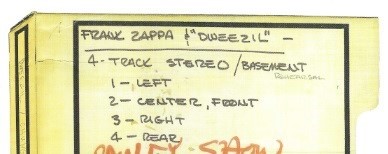 After Zappa had disbanded the original Mothers of invention, he kept on performing live. At first on a lower scale with the
so called Hot rats band. Next there was a short Mothers of invention tour. In the summer of 1970 he picked up his regular
touring schedule again with a new line up of the band, that was performing in this set up for one and a half year. He only
started recording live more seriously with an album in mind in June 1971 at the Fillmore East. The 1971 tour ran from May
through December. For a long time there used to be a gap in the
live recordings from the fall of 1969 through December 1970, the last month of the 1970 fall tour. Not only historically. The sources
over this period were mostly indirect,
in the sense that they weren't part of the official CD catalogue. This changed in 2016 with the release of "Road tapes, venue #3" (see the previous
Chunga's revenge section for an example from this CD), followed by "The Mothers 1970" in 2020. "Quaudiophiliac" is an audio DVD with recordings with a four-channel stereo field,
the oldest being "Chunga basement" from 1970 (to the right the head of the reel, indicating the four fields). The indirect sources
are bootleg recordings and documentaries, that indicate that there is more material worth releasing on a regular CD as well.
In 2023 this situation changed yet again when the ZFT released a three-CD set with material from the recording sessions at the Record Plant from February and March 1973, called
"Funky Nothingness". This section is centered around the studio recordings and touring from 1970.
After Zappa had disbanded the original Mothers of invention, he kept on performing live. At first on a lower scale with the
so called Hot rats band. Next there was a short Mothers of invention tour. In the summer of 1970 he picked up his regular
touring schedule again with a new line up of the band, that was performing in this set up for one and a half year. He only
started recording live more seriously with an album in mind in June 1971 at the Fillmore East. The 1971 tour ran from May
through December. For a long time there used to be a gap in the
live recordings from the fall of 1969 through December 1970, the last month of the 1970 fall tour. Not only historically. The sources
over this period were mostly indirect,
in the sense that they weren't part of the official CD catalogue. This changed in 2016 with the release of "Road tapes, venue #3" (see the previous
Chunga's revenge section for an example from this CD), followed by "The Mothers 1970" in 2020. "Quaudiophiliac" is an audio DVD with recordings with a four-channel stereo field,
the oldest being "Chunga basement" from 1970 (to the right the head of the reel, indicating the four fields). The indirect sources
are bootleg recordings and documentaries, that indicate that there is more material worth releasing on a regular CD as well.
In 2023 this situation changed yet again when the ZFT released a three-CD set with material from the recording sessions at the Record Plant from February and March 1973, called
"Funky Nothingness". This section is centered around the studio recordings and touring from 1970.
NOVEMBER 1969 - MARCH 1970
At the end of 1969 Zappa spent some three months on writing out the orchestral scores for "200 Motels". He still did a
couple of live concerts with the musicians from the "Hot rats" sessions in or around L.A., without a touring schedule.
Two of these shows got bootlegged.
Khaki sack
In the liner notes of "Funky Nothingness" Joe Travers expresses his surprise in finding that much unreleased material on the Record Plant tapes. Indeed very little from these
sessions was used for the next "Chunga's revenge" album and there would have been sufficient material on it for compiling an album in between
"Hot rats" and "Chunga's revenge". "Khaki sack" is a studio recording of a title The Mothers played live earlier in 1968. You can find it as "Whät" on the Beats the boots
CD "Electric aunt Jemima" (with the Spanish symbol from ñ placed on top of the W).
Khaki sack, 0:02-0:38 (midi file).
Khaki sack, 0:02-0:38 (transcription).
"Khaki sack" knows a longer theme, made up of five phrases. It's dealing with letting rhythms appear in various shapes:
- Phrase 1, bars 1-8: a rather simple tune in 12/8 in A Mixolydian, built around alternating the I and V chords.
To a degree this simplicity gets broken by the altered notes from the guitar line (staff 1, notated as it sounds).
- Phrase 2, bars 9-10: these two bars now get subdivided into six instead of four times 3/8. They contain a chord progression, starting upon C and moving towards G Dorian.
- Phrase 3, bars 11-14: now things are getting more irregular. An eighth note remains the time unit and notes/chords can last
an eighth note, a quarter note or a dotted quarter note. I've continued notating this in 12/8, but other presentations are just as well possible.
- Phrase 4, bars 15-18: back to a more normal 12/8 division, but with two chords being played before beat.
It's a progression following the F# Dorian scale with the chords A-B-C#m-B-A.
- Phrase 5, bars 19-22: now where back at the standard rhythm in 12/8.
Starting with bar 23 the basic pattern of this theme gets repeated through the end of this song, first with a guitar solo, next a keyboard solo, followed by a reprise of the theme
as played at the beginning.
Twinkle tits
The bootleg setlist contained an until 2023 unreleased composition called "Twinkle tits", being
an interesting combination of known and unknown themes plus soloing. The title seems to stem from Zappa himself.
In 2009 "Twinkle tits" became part of "Beat the boots III", including the version of this song that was previously known
via the "Apocrypha" bootleg. This song thus became officially available, though at first only with an inferior bootleg sound quality.
On another bootleg album he's said to introduce it with this title, calling it a waltz. If that's so then the term waltz can refer
to the "Holiday in Berlin" part in it. Or Zappa subdivided the opening riff in 12/8 as four 3/8 bars. The general construction of this piece, as
included in the "Apocrypha" bootleg, goes as:
- 0:00-0:13: a joyful riff of one bar in 12/8, played four times.
- 0:14-0:19: a second riff of two bars in 4/4 played once to introduce a guitar solo.
Twinkle tits (BTB III), 0:07-0:25 (midi file).
Twinkle tits (BTB III), 0:07-0:25 (transcription).
The opening riff is in E Mixolydian. The second riff and the soloing continue in E Dorian. The transcription is only
a by approximation one because of the sound quality. It has Ian Underwood on keyboard, Zappa on guitar, Don Harris
on electric violin and Max Bennett on bass.
- 0:19-1:20: first guitar solo.
- 1:21-1:34: the first riff played four times again.
- 1:34-1:42: a third more irregular riff played four times as well.
- 1:43-2:14: section from "Holiday in Berlin" from "Burnt weeny sandwich".
- 2:14-5:37: violin solo by Don Harris, Zappa plays rhythm guitar.
- 5:38-5:49: violin solo ends, the bass keeps vamping.
- 5:49-7:27: second guitar solo.
- 7:27-10:08: closing theme block, officially only known in a demo form from "Joe's domage" (spring 1972). There it's listed as
"Another whole melodic section". See the Grand Wazoo section for a transcription.
Twinkle tits (Funky Nothingness), 3:35-3:53 (midi file).
Twinkle tits (Funky Nothingness), 3:35-3:53 (transcription).
A studio recording of "Twinkle tits" has become available with "Funky Nothingness". So now this song is available with a good sound quality.
It also sounds as finished product. According to the liner notes Zappa recorded nine takes, next to intercuts and overdubs. Joe Travers notes
that Zappa spent a lot of time on this tune, continuing with: "Even still, it remained unreleased during Zappa's lifetime. Portions of this composition were born with
the Mothers of Invention about a year earlier." The example above contains the opening bars of the guitar solo in E Dorian, transcribed from
"Funky Nothingness". Included on this album are also the first two takes, with the first one ending soon due to a false start.
Chunga basement
It's unknown why fine instrumentals as "Twinkle tits" and "Imaginary diseases" (1972) haven't been released by Zappa himself. Not even anything from the tours they were part of.
It's imaginable that at some point he did not think of these songs for inclusion in for instance the "YCDTOSA" series, but that he forgot about whole blocks of touring, that's
highly unlikely. He did include studio material from this period on "Chunga's revenge" and "The lost episodes", whereas the ZFT
would release "Chunga basement" as the central piece on "Quaudiophiliac".
Chunga basement, section (midi file).
Chunga basement, section (transcription).
The beginning of "Chunga basement" is something you might call the lounge bar version of the more rock like "Chunga's revenge"
(the slow tango type cover by the Gotan Project also has something of a lounge bar version). It skips the three guitar chords at
the beginning; they turn up later in the song. The bass riff now gets
divided over two bars, that are minor variants upon each other. The lead melody
is played calmly and smoothly on keyboards, now in the form of a series of chords. The single E-D movement of the melody
at the beginning
has been replaced by a VII-I-IV chord progression in D Dorian for the descant in staff 1 (inclusion of the bass would extend the
first chord to VII 11th).
All notes are now arpeggio chords, played rapidly with the last note on the downbeat.
The notation, via pick-up notes, looks a bit awkward for that reason.
The sound of the keyboard is thick with some vibrato, so I'm not positive about all notes in the chords.
Zappa enters with his solo in the same calm manner: he's playing unusually gentle and rhythmically easy here.
Basement jam
"Chunga basement" is included in "Funky Nothingness" as "Chunga's revenge (basement version)". It got recorded on 3-1-1970 in the basement
of Zappa's house at the Laurel Canyon. On the same day the "Basement jam" got recorded, of which I'm representing the opening below.
Basement jam, 0:00-0:31 (midi file).
Basement jam, 0:00-0:31 (transcription).
It's Zappa soloing in G Mixolydian, though bar 2 suggests G Dorian at first. My guess is that Ian Underwoord is playing the second guitar line.
I'm not sure where the C from staff 3, bar 3, is coming from, maybe someone singing a note in the background. The low D from bar 11 shows that
Zappa must have had his guitar tuned down. I've also included the basis of the drum part,
without much details. Zappa had met Aynsley Dunbar at a festival in Belgium in 1969 and asked him to join his band. Dunbar's drumming is very rich with
Zappa describing him as sounding like two drummers playing the same time. Four examples of them jamming as a duo are included on "Funky Nothingness".
Love will make your mind go wild
"Love will make your mind go wild" and "Sharleena" are the type of love songs he would object to later on in The Real FZ Book, but didn't mind
performing them nevertheless. "Sharleena" got recorded anew for "Chunga's revenge". According to the liner notes "Love will make your mind go wild"
was once selected for "The lost episodes" when it considered to become a three CD set, but eventually it became a single CD issue without this song.
Love will make your mind go wild, 0:00-0:36 (midi file).
Love will make your mind go wild, 0:00-0:36 (transcription).
The example from above is its intro and verse. The intro is an instrumental lick in C Mixoydian with the progression C-C7-Dm7-C.
When the verse starts the scale switches to, nominally, C major. The basic chords per bar are C, Fm, C, Bb, F, F, G, A, etc.,
thus including altered notes. At 1:02 the chorus begins with overdubbed harmonies, giving this song a doo-wop character.
This overdubbed track mixes low and very high voices and, to my ears, has become a little distorted. Disc 2 of "Funky Nothingness"
includes a take without this overdub.
Funky Nothingness
The title track of "Funky Nothingness" is a miniature with a blues-type lick in 12/8. It starts with playing around the F#7 chord with the A# altered to A natural upon the fourth beat.
From 0:23 onwards the guitar line gets doubled by one or two vocal parts.
Funky Nothingness, 0:00-0:18 (midi file).
Funky Nothingness, 0:00-0:18 (transcription).
According to the liner notes "Funky Nothingness" got recorded in 1967 during the "Uncle Meat" sessions. Zappa, Roy Estrada and Motorhead Sherwood get credited for participating.
Apparently Zappa had this track in mind for letting it open the "Chunga's revenge" album in earlier states.
Halos and arrows
"Halos and arrows" is a composition, that, according to the liner notes, survived by coincidence. It's on a tape that got re-used, with this section not being
overwritten. So it begins out of the blue, without knowing how this recording started. Zappa plays two to four accoustic guitars. A bass guitar, a rhythm guitar and
sometimes two lead guitars, sometimes one double-channeled lead guitar. Considering the effort it must have taken recording this, it's strange that Zappa
didn't find it worthwhile to save. It's pleasant music to listen to.
Halos and arrows, 0:51-1:13 (midi file).
Halos and arrows, 0:51-1:13 (transcription).
Because the tape just starts somewhere, it's not that clear what should be seen as the main key. In the example above E Mixolydian is the central scale.
The stable situation at 0:20-0:22 also points at E Mixolydian, but interpreting it as a Lydian D-E alternation is also defendable for some of its sections.
The example from above starts with four bars with the chord progression A-G-A-B as basis, a parallel playing of major triads. Next the soloing continues in E Mixolydian. Bars 6-8
contain the double-channeled lead guitar, the other bars two lead guitars playing at the right and left side of the stereo field. From 1:23 the solo continues as what
you might call a rhythm guitar solo, doing so through the end. See "Chunga's revenge (1975)" from the FZ:OZ section for another example of a rhythm guitar solo.
Moldred
Zappa first met drummer Aynsley Dunbar at a festival in Belgium, fall 1969, where he was promoting Captain Beefheart. He asked Dunbar to come over to L.A. to join his band.
"Funky Nothingness" contains three tracks with them jamming together, listed as "Tommy/Vincent duos". "Moldred" is made up of edited outtakes from these takes,
with Zappa overdubbing himself on bass.
Moldred, 0:01-0:24 (midi file).
Moldred, 0:01-0:24 (transcription).
It begins with playing around a chord progression, G7-Bb-C in G Mixolydian. It's a resolving G7 chord, but with an additional non-scalar Bb chord between the two chords.
This progression gets being varied upon quite loosely till 0:31. At 1:26 Zappa starts playing chromatic lines. The first two bars of the next example
are the end of this chromatic block. Bars 3-6 contain a return to the resolving G7 chord from the beginning, this time just G7-C, thus without an additional chord.
So at this point it's a pure Mixolydian progression. The non-scalar Bb chord returns in bars 7-8.
Moldred, 1:39-2:06 (midi file).
Moldred, 1:39-2:06 (transcription).
"Funky Nothingness", "Halos and arrows" and "Moldred" weren't available when my discussion with Brett Clement came into being.
Brett is giving an argument why Lydian should be seen as the central scale in Zappa's diatonic instrumental music. One of the reasons would be that the stacking of thirds
upon the Mixolydian tonic comes to a halt at the triad, while Lydian allows all possibilities up to the 13th chord. The Mm7 chord should be seen as destabilizing in Zappa's music. "Funky Nothingness" and "Halos and arrows"
show more possibilities to a small degree, but "Moldred" quite explicitly. Brett went as far as calling the Mm7 chord prohibited with its resolving tendencies
being the reason. But that's exactly what Zappa is doing here. You can read more about this in the Zoot allures section.
APRIL - MAY 1970
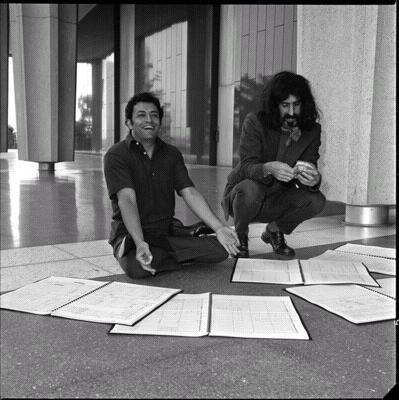 In December Zappa was offered the opportunity to have his
newly written score premiered by the L.A. Philharmonic
Orchestra, conducted by Zubin Mehta. To give this one time concert more body and publicity, he wanted his rock band
to take part of it. He was able to regroup the former Mothers of Invention for a short reunion tour. The series
of a dozen venues were meant to prepare for the concert with Mehta, to be held at the Pauley Pavilion. It turned
out to be a major success, with this sports stadium filled to the full. To the right Zubin Mehta sitting with Zappa in front of
the 200 Motels scores (from Changing Times: Los Angeles in Photographs, 1920-1990; photographer unknown).
The following quotation can be found at http://www.time.com/time/magazine/article/0,9171,878305,00.html:
""Most rock groups could not do this sort of thing because they cannot read music," said Zubin Mehta confidently.
"Frank Zappa, on the other hand, is one of the few rock musicians who knows my language." As conductor of
the Los Angeles Philharmonic, Mehta is known not only for his willingness to step in where many Angelenos
fear to tread but for his ability to get away with it musically."
In December Zappa was offered the opportunity to have his
newly written score premiered by the L.A. Philharmonic
Orchestra, conducted by Zubin Mehta. To give this one time concert more body and publicity, he wanted his rock band
to take part of it. He was able to regroup the former Mothers of Invention for a short reunion tour. The series
of a dozen venues were meant to prepare for the concert with Mehta, to be held at the Pauley Pavilion. It turned
out to be a major success, with this sports stadium filled to the full. To the right Zubin Mehta sitting with Zappa in front of
the 200 Motels scores (from Changing Times: Los Angeles in Photographs, 1920-1990; photographer unknown).
The following quotation can be found at http://www.time.com/time/magazine/article/0,9171,878305,00.html:
""Most rock groups could not do this sort of thing because they cannot read music," said Zubin Mehta confidently.
"Frank Zappa, on the other hand, is one of the few rock musicians who knows my language." As conductor of
the Los Angeles Philharmonic, Mehta is known not only for his willingness to step in where many Angelenos
fear to tread but for his ability to get away with it musically."
Zappa wanted but couldn't record the concert,
not even for private use. In order to do that he would have to pay the whole orchestra a union regulated fee, which
was too expensive. When he wrote "Stick together" in the early eighties about union corruption, it was more than
social criticism. It was personal resentment. So the only available documentation of this event is a bootleg version.
In the "The Mothers 1970" booklet Joe Travers writes: "The demand for the original Mothers Of invention was becoming unavoidable and
some re-union shows were destined to be organized. Sadly, none of these shows have been found in the vault".
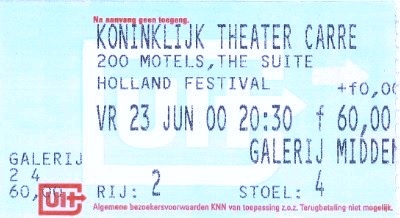
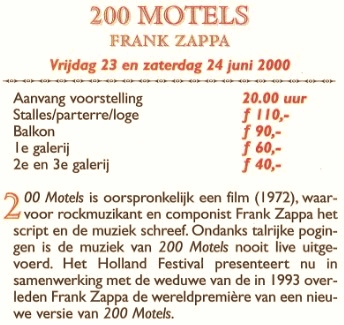
The second public performance of "200 Motels", in the shape of The suites, was planned for 1971 at the Royal Albert Hall, but got cancelled because of unappropiate
lyrics. It would take till 2000 before "200 Motels, the suites" got premiered during the Holland Festival at the Carré theatre in Amsterdam.
Dance of the just plain folks
The bootleg pressings include "Tuna sandwich", so next is a sample of the "Tuna sandwich" section of score. The first corresponding execution on album
can be found on "200 Motels" as the opening of "Dance of the just plain folks". In the original score for "200 Motels" this
section is called "Tuna sandwich ballet" (image below). The bars below contain changing meters, triplets and a tempo change. The main melody
follows scales that keep changing.
Dance of the just plain folks, opening bars (midi file).
Dance of the just plain folks, opening bars (score).
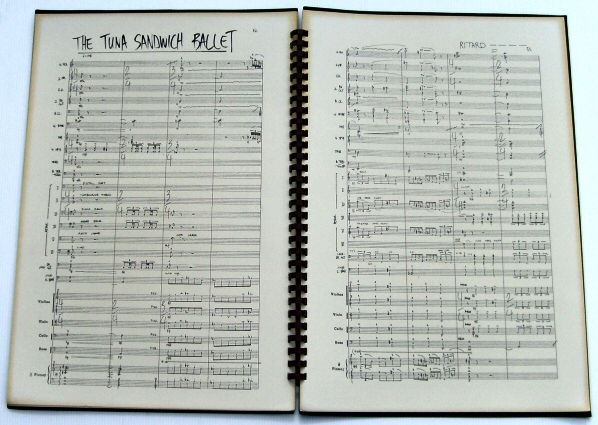
Along the way Zappa still wanted to finish his "Uncle meat" movie project. He was able to arrange a filming crew for a
friend's price. He thought about interviewing the Mothers individually, so that it would be a documentary about the Mothers in the
sixties. But when the members of the band got confronted with this unannounced project, they were reluctant to cooperate. So Zappa
had to come up with something new, characterized by making something out of nothing, a method for which he praises John Cage
on the "Lumpy Money" CD. Things were improvised on the spot and in the final edit nothing was done to conceal this. Don
Preston took the major role as the monster Uncle Meat. Some of the acts and phrases used in it are thus bizarre that
the result proves to be entertaining, despite of the extreme low budget.
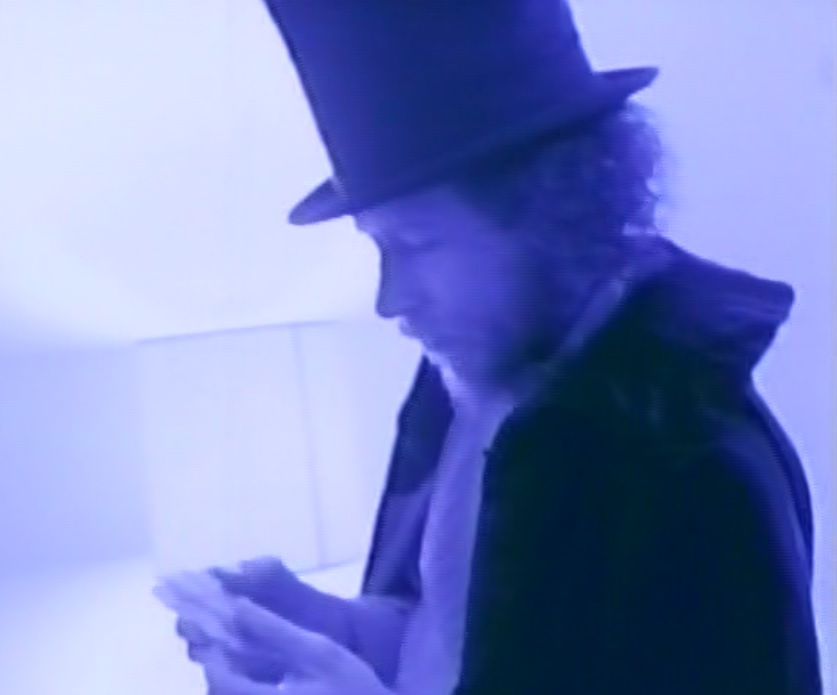
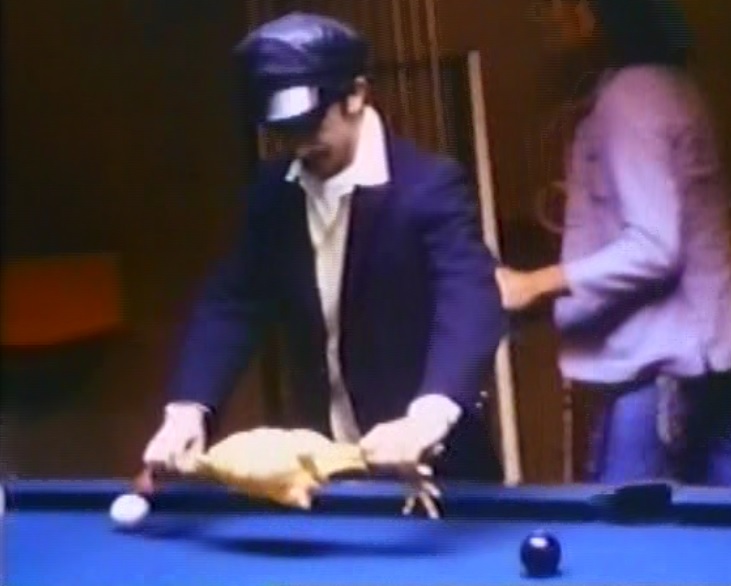
Two stills from the Uncle Meat movie, 1970 takes. Left: Don Preston in the bathroom of Zappa's house. Right: the famous rubber chicken to measure things.
JUNE - DECEMBER 1970
In June 1970 Zappa had assembled a new line up of the Mothers of Invention and picked up his regular tour schedule again.
The fall tour lasted through December with venues in both Europe and the U.S., usually with a concert in Canada attached
to it. Today there is official coverage, though it used to be a bit scattered for long. At the start of the tour, two songs were radio-broadcasted
in Holland. They are included in the "At the circus" bootleg from the "Beat the boot series".
There's some live footage from 1970 included in the "The true story of 200 Motels" video as well
as "Do you like me new car" and "Penis dimension". Zappa himself
recorded the "Nancy and Mary music" live for "Chunga's revenge". The concert it was taken from, got released by the ZFT
in 2016 as "Road tapes, venue #3". Jean-Luc Ponty included a live version of "King Kong"
from this time on his album playing Zappa's music, though with a different one time only set up of the band.
In 2020 the ZFT came out with "The Mothers 1970", 4-CD box covering this year's touring as well as studio recordings at Trident Studios, June 1970.
It's an important release, not only historically for covering 1970 well by now, but also by including some interesting unreleased titles.
Like "Twinkle tits", it remains unclear why "Red tubular lighter" and "Giraffe-take 4" never got released by Zappa himself. It also turns out
that "Easy meat" and "Envelopes" were composed for this tour. In this case he kept working on these titles till they got splendid "final" performances
on albums from the early eighties.
Red tubular lighter
Next is the opening track from "The Mothers 1970", an instrumental with Zappa being credited for playing all guitar and bass parts. It's included as
a 9-minute unedited version and a 4-minute final version. Next to having half of it edited out, the final version also contains additional overdubs.
The first example below is the opening theme. It's a riff of two bars in A Mixolydian, made up of a motif played in two variants. It gets played for times
in total before this piece moves over to soloing. The soloing can be divided into a couple of blocks with the participating guitars/bass switching who's playing lead, sometimes
with transitions between them.
Red tubular lighter, 0:00-0:12 (midi file).
Red tubular lighter, 1:36-1:51 (midi file).
Red tubular lighter, 0:00-0:12 (transcription).
Red tubular lighter, 1:36-1:51 (transcription).
The second example contains one of such transitions. Bars 1-3 are the end of a soloing block, leading to a transition happening during bars 4-6. This
transition contains a continuation of soloing along a chord progression: A-A7-G-C-G-A-G-A. It's mostly an alternation of the A and G chord with once
a C chord as passing chord between them.
In the Zoot allures section of this study you can find the Lydian theory of Brett Clement being discussed, where
he calls the A7 chord in it prohibited. On an intellectual level I can follow his reasoning: the overall Lydian tonic of his theory would be G in this case and the A7 chord
would leave this G in need of resolution, undermining its stability. In a practical sense this has no meaning to me, because I'm not listening to an overall Lydian tonic, let alone that I would care about its stability.
Quite the contrary, this passage sounds beautiful to me, far from untypical of Zappa. You can also notice that he doesn't let this A7 chord resolve to D, it moves over to G.
The central key in "Red tubular lighter (unedited master)" is A Mixolydian, but you can also hear other keys passing by:
- 3:52-4:19: B Mixolydian.
- 4:19-4:40: I-II alternation in A Lydian.
- 8:22-9:24: E Dorian.
Mostly vamps are being used, next to pedal notes. Two more guitar solos are included in "The Mothers 1970", probably outtakes from songs, but presented as individual tracks:
- "Portuguese fenders": a pedal note solo in D Dorian.
- "Guitar build '70": starting as a vamp/pedal note solo in E Dorian. At 1:29 a figure in D Lydian begins, comparable to the first "Holiday in Berlin" example from below.
It features the I-II alternation some more, sometimes also using VII. It ends with an extremely long sustained D note (guitar feedback), 2:29 through 3:02.
From that point onwards this solo continues in D Dorian.
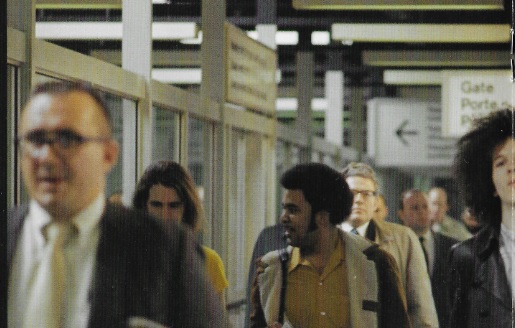
Outtake of a photo from the "The Mothers 1970" booklet featuring Ian Underwood, George Duke and Jeff Simmons on the road in an airport hallway.
Giraffe-take 4 (Lola Steponsky)
"Giraffe-take 4" is the longer earlier recording of a composition, that got re-titled to "Lola Steponsky" once the lyrics got added.
During the first 5 seconds you can hear someone saying "Giraffe, take 4, one, two, three, four".
It belongs to the category of being multi-anything. Regarding the two examples below:
- The meters: 2/4, 3/4, 4/4, 5/8 and 7/8.
- The rhythm: next to triplets you can find odd subdivisions over two beats, as 2+3+3 (bar 2), 3+3+2 (bar 4) and 3+2+3 (bar 8).
- The scale: the music is basically diatonic but with notes from varying scales and without stable tonics.
The first example with what you might call theme one is to a degree monodic, but chords can be heard because of parts diverging a little. The second example
contains explicit chords.
- The themes: the composed section knows a number of themes made up series of motifs or sequences. Only bars 4-5 from theme one show a repetition. Bars 3, 6 and 9 are
variations upon each other. The other bars contain different motifs each time.
Giraffe-take 4 (Lola Steponsky), 0:05-0:22 (midi file).
Giraffe-take 4, 6:10-6:27 (midi file).
Giraffe-take 4 (Lola Steponsky), 0:05-0:22 (transcription).
Giraffe-take 4, 6:10-6:27 (transcription).
The composed sections ends at 1:36, being followed by a drum solo through 3:05. Next the composed section gets a reprise.
From 4:10 onwards this song moves over to a free improvisation block with many references to the composed material. The second example is an outtake
from this block with two less common chords alternating: Bb-add2 and Gsus2. Both the guitar and bass can add chromatic notes to this progression, making
it sound kind of rough. Specifically the guitar figure from bar 5, staff 2, sounds brutal in this context.
Solos from Holiday in Berlin and Call any vegetable
For long most material from this tour stemmed from three bootlegs from the "Beat the boots" series. Both "Tengo na minchia tanta"
and "Freaks and motherfu*#@%!" were recorded at the Fillmore East, November 1970. They largely overlap. The first is of a far better sound
quality, though the latter contains "Call any vegetable" uniquely. The following three guitar solo examples are taken from these
two bootleg recordings. The "Holiday in Berlin" solo is listed as s separate track, "Inca roads/Easy meat", on "Tengo na minchia tanta".
In the movie scores section I explained my preference for naming it a "Holiday in Berlin" solo (same D Lydian solo type).
The one from "Call any vegetable" corresponds with the solo from "Invocation & ritual dance of the young pumpkin" from the Absolutely
free section. The B-C#-D-C# movement by the flute has been replaced by the chord progression I-IV-V-IV in E Dorian.
The IV and V chords only
contain the third, so the high notes from the chords follow the original flute tune. Rhythmically they do the same on beat -
before beat alternation of the four notes/chords.
Holiday in Berlin solo (1970), section #1 (midi file).
Holiday in Berlin solo (1970), section #2 (midi file).
Call any vegetable solo (1970), opening (midi file).
Holiday in Berlin solo (1970), sections (transcription).
Call any vegetable solo (1970), opening (transcription).
These three solo sections show how Zappa's style of soloing developed when you're comparing them to his later solos. The
following remarks are applicable only in general:
- The rhythmical figures in his early solos are less complicated than in his later solos, that are full
of irregular rhythmic groupings. The larger part of the bars above is
fit for sight reading for a trained musician. This is something that can't be said of the solos that Steve Vai transcribed
for the Guitar book. The "Orange county" solo section from the Roxy section is a good example of a readable earlier solo.
The "Hot rats" solos, that Andy Aledort transcribed, confirm this picture.
- The emotions in the melodic lines are less abstract than in his later solos. His style in the examples above is lyrical,
almost romantic. Zappa created an image of himself that can't be associated with romanticism or love songs. But
when you hear Bianca Odin singing "You didn't try to call me" on "Philly '76" or the above solo, you can see that things
are never a rule for him.
- In his earlier solos there's more room for the accompaniment to take part into the solo. The types of accompaniment
have always remained the same, see the Guitar section for that matter, but in his earlier solos the accompaniment could
respond to the solo more readily. For his later solos Zappa mostly wanted things as a reliable steady vamp. The band could vary
around the vamp, but not interfere with his playing. Above in the second "Berlin" transcription you can see an example of
the bass player responding to the solo. In bar 6 Zappa goes from low notes to fast high notes, starting with an F#. The
bass player reacts to this by playing F# himself in bar 7, instead of going back to D, as the chord alternation would
require. Here it works out well in accentuating the emotional density of bar 7.
The "Vegetable" solo following upon it
can only be found on the "Freaks and motherfu*#@%!" bootleg.
Most of the bass part is about inaudible. I've included what I can hear as well as the keyboard part,
for some of the solo's finesses lie in the cooperation between the guitar solo and the accompaniment.
This solo appears to be more preconceived than usual and the construction of this particular section is quite unusual in
Zappa's oeuvre.
- The drum part in his earlier solos is less elaborate than in his later solos. Specifically Jimmy Carl Black used
to play just the beat, whereas Vinnie Colaiuta said that for Zappa you could hardly get over-excited drumming to his solos.
Who are the brain police? (1970)
The third bootleg from "Beat the boots", covering this tour, is "Disconnected synapses". It contains material from a concert
at Paris, December 1970, that also got broadcast on French TV the next year. Below follows a variation upon "Who
are the brain police?" to be found on this bootleg. The original song is included in the "Freak out!" album,
with an example being presented in the corresponding section of this study. This 1970 version is re-using the lyrics, but
the music goes that different that it almost has become a new song. Only in very general terms some similarities can be discerned in the music.
Notable of this specific version are the irregular rhythm and large interval jumps in the
bars with lyrics:
Brain police variation (Paris, 1970), theme (midi file).
Brain police variation (Paris, 1970), theme (transcription).
- Bars 1-4: opening with stressing the C via two triplets (or sixtuplets) in beats 1-3.
- Bars 5-8: a I-III-IV-I progression in C Dorian.
- Bars 9-12: main theme. In bar 9 you can hear a Bb going to F over an octave, thus a jump of a 12th. Bar 10 is a
variation upon bar 9. On beat one the triplet rhythm is left for a split second for two 16th notes. The interval jump on beat three gets
reduced to a 9th.
- Bars 13-17: second theme.
In the Carnegie Hall section another version of "Who are the brain police?" is included, played
in a different manner a year later.
